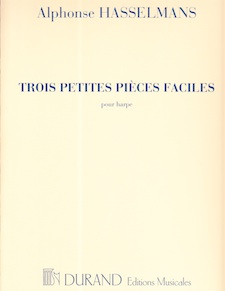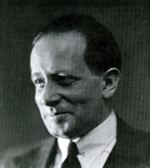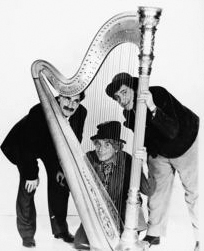|
The list below represents some of the "late greats" of the harp. These people were influential not only as performers, but also as composers for the harp. Their historical influence for the instrument was legendary. |
||||||
King David (907 B.C.-837 B.C)According to accounts in the Old Testament, David would often play the harp to sooth King Saul, who was the first king of Israel. Saul was often affected by depression, and David's harp playing calmed Saul's temper. Later, David took Saul's place as king of Israel. After a reign of 40 years, he passed away and was buried "in the city of David." Thus, David may have been the first documented music therapist! |
 |
|||||
Turlough O'Carolyn (1670-1738)Turlough O'Carolyn was a well-loved Irish harpist, who traveled throughout the country composing and performing harp pieces in exchange for food and lodging. He wrote many tunes for specific people who he met during his travels. One of the most interesting facts about O'Carolyn is that he was a blind harpist. His tunes are still some of the most-loved by harpists and Celtic groups throughout the world. (Jean-)Francois-Joseph Naderman (1781-1835)Naderman was the son of the famous harp maker Jean-Henri Naderman, and was born into a very musical family. His father became especially well-known after building a single-action pedal harp for Marie Antoinette. This single action harp resembled the early 18th-century Hochbrucker model. Young Francois-Joseph studied with Krumpholtz and soon began touring Europe as a virtuoso of the harp. In 1815, Naderman became the harpist for the Royal Chapel, and in 1825, he because the first harp professor of the Paris Couservatoire. During Naderman's lifetime, there was a surge of interest in the double-action harp created by Sebastien Erard. However, Naderman continued to teach the single-action harp at the Paris Conservatoire. Naderman's Sonatas Progressives are still regarded as some of the most important in harp repertoire today. |
||||||
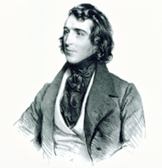 |
Elias Parish Alvars (1808-1849)The English harpist Parish Alvars is frequently described as "the Liszt of the harp." He was born in Teignmouth, Devonshire. He lived in Vienna in the 1830's, and became the first harpist with the Imperial and Royal Opera there. In 1842, Parish Alvars purchased a "Gothic model" Erard double-action harp. Using this harp, he developed many new techniques, such as harmonics in double, triple, and quadruple, chordal glisses, and virtuosic enharmonic effects. Liszt described him in Neue Zeitschrift fur Musik as having "a somewhat rugged appearance; his gigantic figure, with his square shoulders, recalls the mountain peasant. His face is comparatively mature for his years, and from underneath his prominent forehead speak his dreamy eyes expressive of the glowing imagination which lives in his compositions." |
|||||
| He frequently traveled and performed in London and Northern Germany, and he published over eighty solo harp works, many of which are among the most difficult music in the harp repertoire. | ||||||
|
||||||
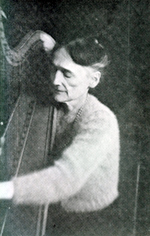 |
Henriette Renie (1875-1956)Renie was one of the first well-known female harpists. She was born in Paris, and she first heard the harp played by Hasselmans at a concert in which her father sang. After the concert, she proclaimed to her father "That man will be my professor of harp." She began to study the harp three years later with Hasselmans, and progressed so quickly that her father soon had to create extensions so that her tiny feet could reach the harp's pedals. Renie began studying at the Paris Conservatoire at the age of ten, and at eleven years, she won the Premier Prix playing the Concertino for Harp and Orchestra by Oberthur. Renie was a devout Roman Catholic, and her faith grew, even during the religious distress that came with the institution of the Third French Republic, and seeing two World Wars during her lifetime. Hasselmans and Renie are often regarded as two of the most important supporters of the Erard double-action harp. At the Brussels World Fair in 1897, Renie featured the Erard harp in a booth that was adjacent to that of the Pleyel chromatic harp. Interestingly, Renie was partially responsible for the creation of the Pleyel chromatic harp, through her comments about the difficulties and complexities of the pedals. |
|||||
| Renie has composed some of the most virtuosic and sonorous works for harp, in addition to many important pedagogical compositions. Her deep love and faith show through in the beauty of each individual composition. | ||||||
|
||||||
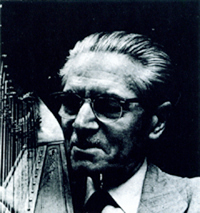 |
Marcel Grandjany (1891-1976)Grandjany's introduction to music came from his father's side of the family. His father was a piano technician, and his uncle taught organ and solfege at the Paris Conservatoire. Grandjany's cousin, Juliette, was also a prize-winning musician and graduate of the Paris Conservatoire. It was this cousin who saw Grandjany's musical potential and began teaching him piano and solfege. Grandjany progressed quickly, and entered the Conservatoire at the age of nine. Shortly after, Juliette contacted a friend of hers, Henriette Renie, to ask if Grandjany might have a future as a harpist. Mme. Renie was particularly excited with his audition. He continued to study with Renie, but later his association with the Paris Conservatoire required that he take harp lessons with Hasselmans as well. |
|||||
|
He continued to study with both teachers and in 1905, Grandjany won the first prize playing the Renie Concerto. After a brief hiatus during World War I, Grandjany resumed his concert career, performing in New York at Aeolian Hall in 1924. He continued to perform in Paris and also the United States, and his playing was respected by President Roosevelt and Thomas Edison. In 1935, Grandjany settled in New York and began teaching the harp at the Juilliard School of Music. Grandjany's compositional works speak of his deep spiritual nature and his deep commitment to the art of playing the harp. Grandjany's primary means of teaching was by example which also attests to the manner in which he lived. His devoted students and his soulful compositions are both a testament to his legacy. |
||||||
|
||||||

